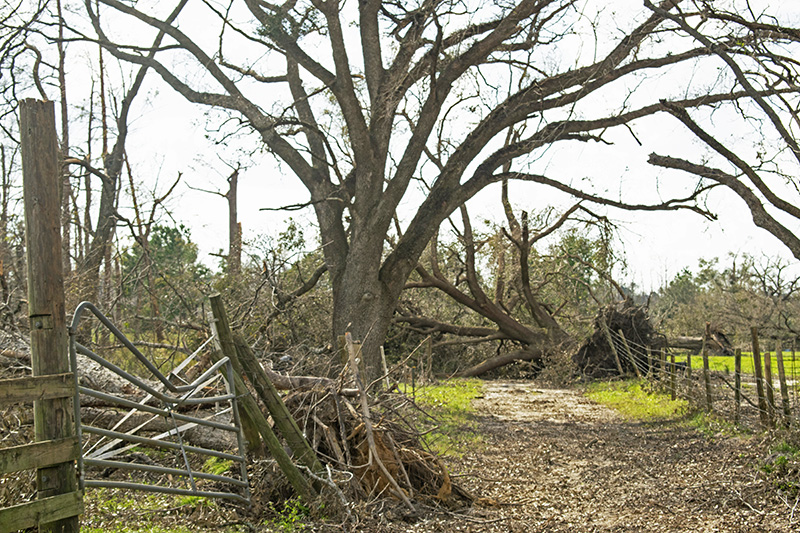Even with hurricane season now in effect, it’s not too late to be prepared for a potentially damaging storm. As with having a plan for you and your family, it’s important to have a plan for your ranch. Being proactive is key to saving and protecting you and your family, as well as your valuable assets.

Beautiful, large shade trees in fence-lines became a horrific mess to restore after Hurricane Michael, in Jackson County. Credit: Doug Mayo, UF/IFAS
–
Your ranch preparedness plan should include loss prevention measures of the operation. Begin the process by photo documenting your property in a normal state. It’s a good idea to do this annually for insurance purposes. Inspect your property and consider what the effect strong winds and heavy rain may have on structures and equipment and what could be deemed high risk areas for livestock (close to falling trees, etc.). Consider moving livestock from high impact areas to interior pastures and having a mechanism for securing water for several days are both paramount. Using non-restrictive ID tags for horses and livestock can be very helpful in the event of downed fences. Have a plan to cover feed that could spoil in secure bins and anchor with ties. You will want to move vehicles and essential equipment from buildings that may collapse under strong winds.
What supplies do ranchers need to stock up on? Power and many goods and services will most likely be unavailable for some time. Here is a checklist of supplies you may need:
- Generators/fuel (diesel, gas, mixes)
– - Battery/crank radio
– - Batteries and flashlights, power cords
– - Various sized tarps
– - Rope, straps, tape, staple gun/staples
– - Chain saw, oil, new chains, chain files
– - Means of livestock euthanasia
– - Solar fence charger/tape, etc.
– - T-posts, clips, barbwire and smooth wire
– - Fencing tools and bolt cutter
– - Hay for sacrifice area
– - Insect repellent (consider DEET)
– - Drinking water and electrolytic drink mix
– - Crates for pets
–
Keeping good records can save valuable time in recovery assistance. Be sure to keep an updated list of insurance policies/agents and contact information for your local USDA-FSA Office, cattlemen’s association members and area veterinarians.
What about after the storm? Prioritize your safety and health during cleanup efforts but also look out for the health and safety of your animals. Here is a short checklist to keep you safe!
- Turn off damaged electric fencing
– - Photograph damage
– - Check fencing
– - Collect debris
– - Supply feed/hay and clean water to livestock
– - Beware of toxic plants and downed trees
– - Consider a contingency plan for annual forage plantings
–
Following these steps will help keep you and your animals safe during the Hurricane season. For more information, reach out to your local county extension office.
–
Information for this article provided by Victor Guerra, Dr. Ann Blount and Dr. Cheryl Mackowiak of the UF/IFAS North Florida Research and Education Center.
Supporting Information
Tucker, J.J., D.W. Hancock, L. Stewart, and J.R. Segers. 2019. Dealing with pasture, hay, feed and livestock losses after significant weather events. UGA circular 1165:
UF/IFAS Disaster Preparation & Recovery: https://disaster.ifas.ufl.edu/
–
Other Resources
Hurricane Preparedness for Equine and Livestock
Hurricane Preparedness and Recovery for Equine
Equine Care Checklist: Before and After the Storm
Cattle Care Checklist: Before and After the Storm
USDA Hurricane Preparation and Recovery Guides for Florida Producers
- A Balanced Approach to Managing Florida Panhandle Forested Lands for Wildlife - January 16, 2026
- Challenges Using Oxalic Acid Against Summer Varroa Mite Infestations for Panhandle Beekeepers - July 11, 2025
- Managing Pine Stands for Straw Production - January 10, 2025
